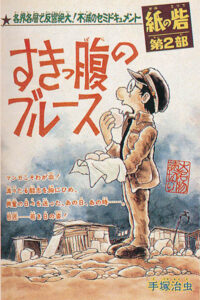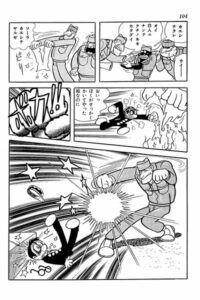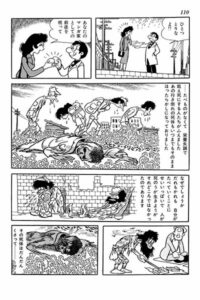Hungry Blues (Manga)
also known as すきっ腹のブルース (Sukippara no burūsu)

| English Title: | Hungry Blues |
| In English? | No |
| Japanese Title: | すきっ腹のブルース Sukippara no Burusu |
| Type: | Short Story |
| Original run: | 1975/01/01 |
| Published in: | Weekly Shonen King 週刊少年キング |
| Published by: | Shonen Gahosha |
| Volumes: | 1 (MT-274) |
The semi-autobiographical short story Hungry Blues (1975) was originally published as a short story in the January 1, 1975 issue of Weekly Shonen King.
What it’s about
Although the war had recently, in 1945 people in Japan were still faced with severe food rationing – which often meant were left with two options – stealing food from farms, or begging American G.I.’s for chocolate and other goods. A young cartoonist name Osamu Tetsuro is reduced to both. However, when a young black soldier realizes how good an illustrator Tetsuro is, he starts offering food in exchange for drawings. However, the racial tensions even among the American occupation forces are tricky to navigate and Tetsuro ends up getting beat up by some white G.I.s for his troubles.
However, as luck would have it, he meets a beautiful young lady named Kazuko Kawahara who works at a newspaper. After showing his drawings to her editor, Tetsuro is hired to provide artwork for publication. Despite the terrible conditions – with the bodies of people who have starved to death just lying around in the street – Tetsuro treats Kazuko to a meal to celebrate his new job. Although Kazuko is confident that Japan’s fortunes will change and that her work at the newspaper will prove that “the pen is mightier than the sword”, Tetsuro maintains that it’s hard to fight on an empty stomach.
As his relationship with Kazuko develops, Tetsuro finds it harder and harder to concentrate on drawing any manga – instead just drawing her face repeatedly. After the two take shelter in a secluded corner during a food riot Kazuko takes the opportunity to kiss Tetsuro – which only makes him even more smitten. Although Kazuko invites Tezuka to come and visit her place two days later, he stops by a local Chinese restaurant to grab a meal first. However, when the cook is taken into custody by the police, Tetsuro refuses to leave until he’s had his meal. As he waits, he realizes that his feelings of hunger are mightier even than his love for Kazuko, and by the time he finally arrives at her place… she’s gone.
What you should know
Hungry Blues (1975) is the sequel to Paper Fortress (1974), and part two of a planned trilogy – the third part of which never came to pass – detailing the war-time and early post-war life of manga artist, Osamu Tetsuro… a thinly veiled stand in for Osamu Tezuka himself.
Although the final part of the “Paper Fortress Trilogy” was never completed, Paper Fortress (1974) and Hungry Blues (1975) are considered part of a group of short stories that Tezuka produced in the 1970s – along with Zephyrus (1971), The Godfather’s Son (1973), and Mount Monmon is Crying (1979) – each drawing on some semi-autobiographical elements from Tezuka’s own experiences. While Paper Fortress (1974) focuses on the fear and horror of the last days of the war, Hungry Blues (1975) shows that even after the war had finally ended, the suffering of the people continued as a food crisis gripped the country.
Tezuka once again draws from his own personal experiences during the occupation. For example, although the scenes with the black American soldier are fictional and used for dramatic effect, they are based partially on a true story from Tezuka’s own life. In 1946, while studying medicine at Osaka University he sometimes would skip lectures to play the piano at the nearby YMCA. One day, while he was playing Mozart’s Turkish March, a black soldier entered the room and began to sing a Mozart aria. Although Osamu Tezuka didn’t speak English, he was able to learn that the soldier’s name was “Joe.” After drawing a quick caricature portrait of him, Joe responded by bringing Tezuka a mountain of American comic books – much to his delight.
Although their friendship was brief, Tezuka would later say that it was one of the reasons he decided to continue on with his career in manga even though he was pursuing a medical degree.
Stars Spotted:
-
-
- Osamu Tezuka as “Osamu Tetsuro”
- Geta as “the police officer”
-





Leave a Reply